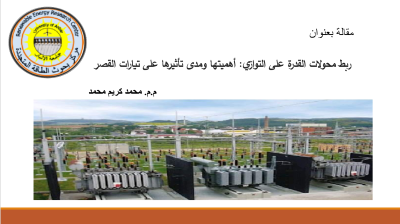|
Connecting power transformers in parallel: importance and effect on short-circuit current
2022-05-20

Assist. L. Mohammed K. Mohammed
Due to the increasing demand for electrical energy and the expansion taking place in cities, such as building residential complexes and laboratories, it has become necessary to exploit the capacity supplied to substations and provide consumers with the maximum capacity possible. In this article, two principles of electrical power systems will be interlocked:
1- Connecting the transformers of the substation in parallel
The process of connecting transformers in parallel increases the power supplied to consumers as well as provides high efficiency and reliability. When connecting transformers in parallel, one of them can be stopped for maintenance without causing a loss or interruption in the supply of the loads (especially when the remaining transformers have sufficient capacity to supply the loads). Sometimes it is not possible to stop the preparation of the load, as in hospitals and laboratories. There are several conditions that must be applied when connecting electrical power transformers in parallel, which are:
· Voltage ratio
· Same polarity
· Same phase sequence
· Same impedance ratio
In addition, the process of connecting transformers in parallel contributes to reducing losses. A sample was taken, which is the substation in East Ramadi (132 kV) and analyzed using the ETAP program. The station contains three transformers. Several scenarios were taken, namely connecting the three transformers in parallel and then connecting them in a manner individually and connecting two transformers in parallel. As shown in Figure (1), the losses were reduced in the case of parallelism by 18%.
.png)
At the same time, the process of connecting in parallel increases the amount of short-circuit current, as will be explained in the second principle.
2- Short circuit current
The passage of a huge current in an unsuitable path may cause serious damage to equipment and workers. Therefore, the values of the short-circuit current must be calculated to adjust the protection system according to the values of the current to reduce its impact on the electrical system. There are several international standards for calculating short-circuit current. Here we will address two standards, first European standards, which are (IEC) and the second American standard (ANSI), to show the extent of the impact of parallel connection of transformers on the value of short-circuit current. When examining one of the buses in which a fault may occur in the East Ramadi substation through a simulation in the ETAP program, it was found that the results obtained confirm what we mentioned above, which is that the short-circuit current increases when connecting transformers in parallel. As shown in figures (2) and (3).


We conclude that connecting transformers in parallel contributes to:
1- Increasing the capacity of the station to supply the most energy to consumers.
2- Permanence of energy supply and un interruption, as well as the possibility of maintaining the transformer without interruption.
3- Reduce losses.
4- Increase short circuit current.
Reference:
1- J. Doneski and N. Acevski, “Parallel Operation of Transformers Conditions, Application and Economics,” icest, pp. 645–648, 2004.
2- Z. Ed, “Loading Considerations When Paralleling Transformers,” Schneider Electr., no. October, pp. 1–16, 2011, [Online]. Available: http://www.schneider-electric.us/en/download/.
|